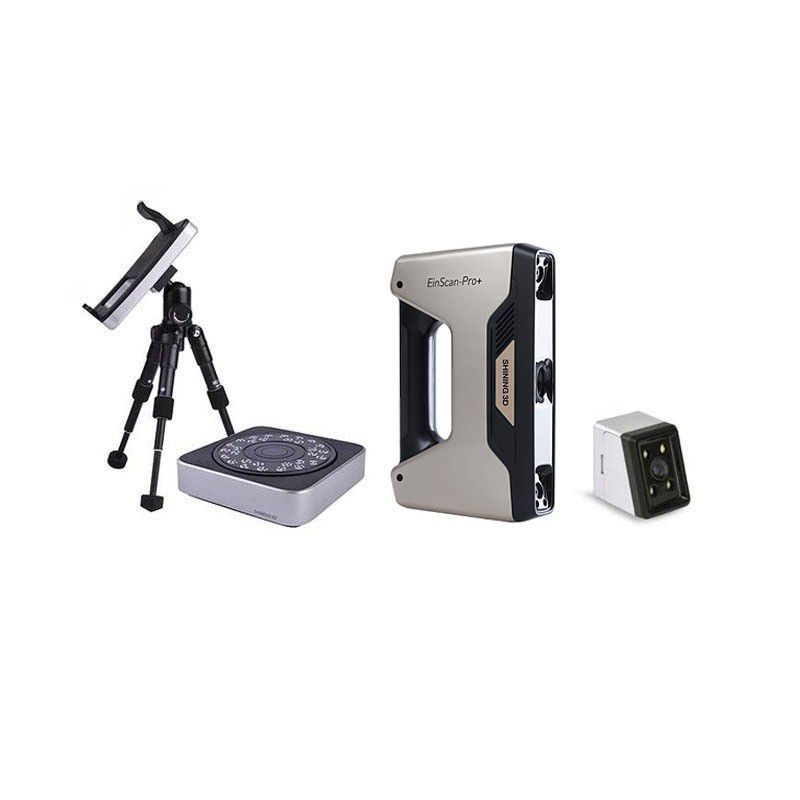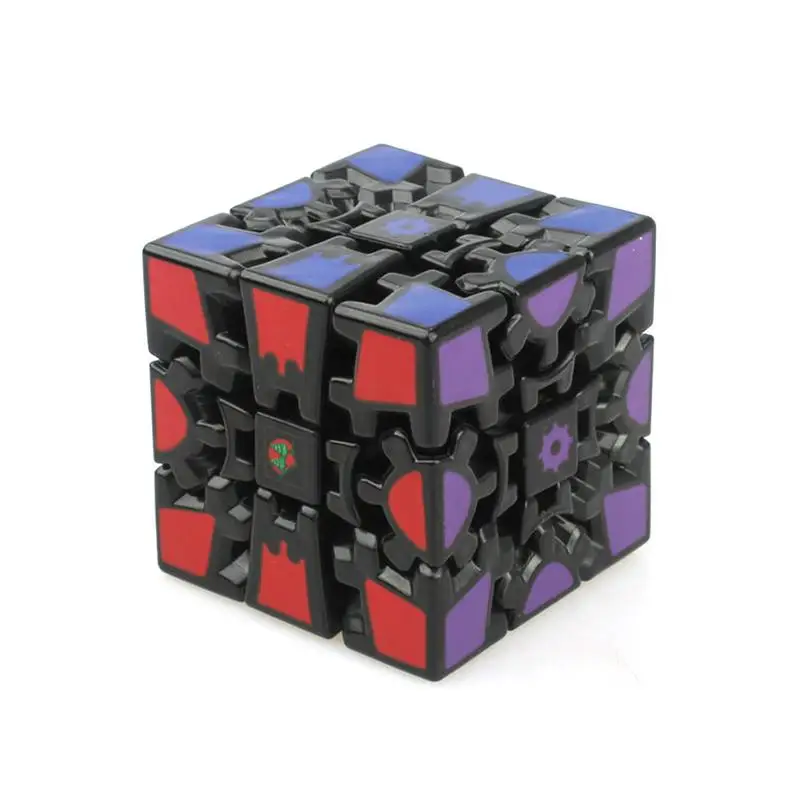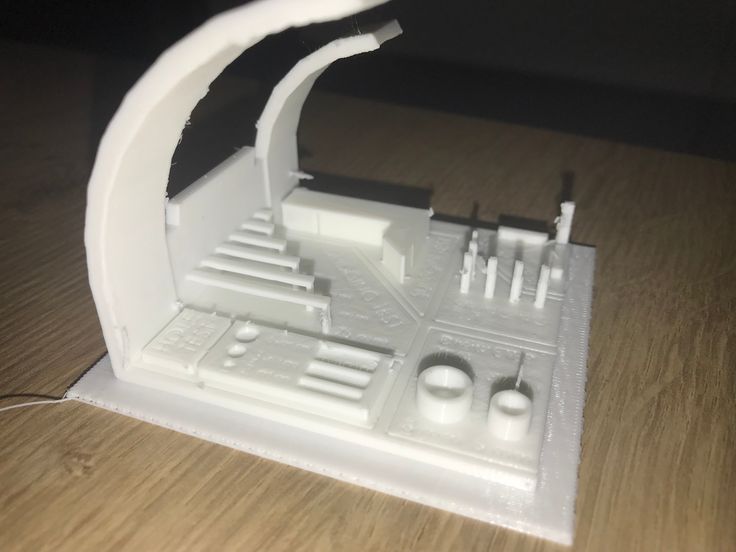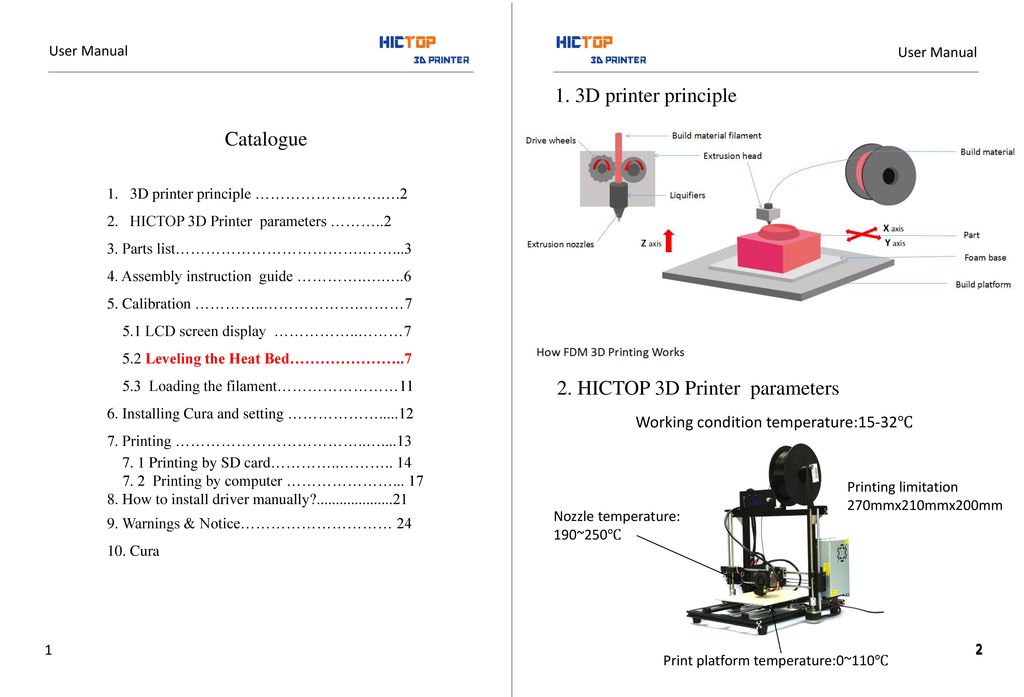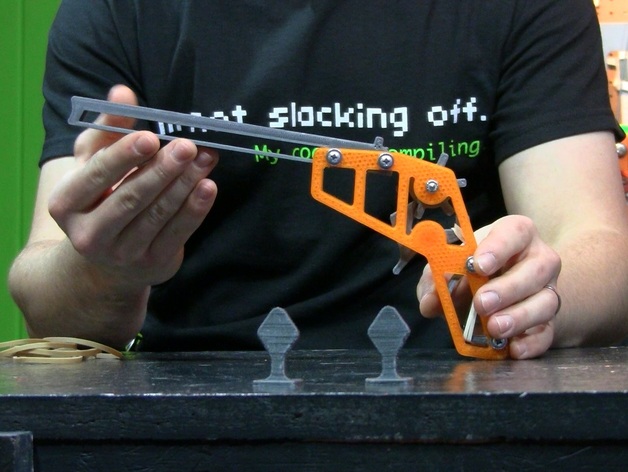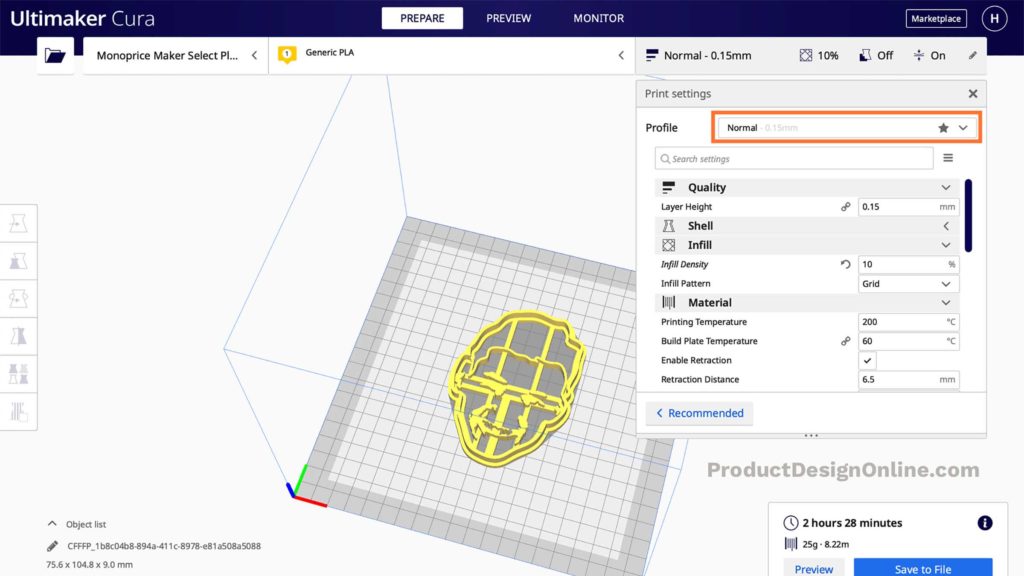Best hand held 3d scanner
Best handheld 3D scanners under $30K
Looking for the best handheld 3D scanner? This selection features what we believe are the 6 best handheld 3D scanners under $30,000, based on our own experience as well as feedback from our trusted network.
Last update April 27, 2022
In our last major update, we swapped out the Scantech KSCAN-Magic for the SIMSCAN that we tested weeks earlier. We also added the FreeScan UE Pro, Shining 3D's recent follow-up to the metrology-grade FreeScan X series. We swapped out the Go!SCAN SPARK for the HandySCAN 307 to narrow this selection's price range down to $30K. Minor updates were also made to the buying guide section.
Table of contents
What is the best handheld 3D scanner on the market?
Our handheld 3D scanner selection this year (under $30K)
peel 2
EinScan HX
HandySCAN 307 (SILVER series)
FreeScan UE Pro
SIMSCAN
Leo
Purpose: What do you need your 3D scanner for?
Handheld 3D scanner specifications
Budget
FAQ
What is the best handheld 3D scanner on the market?
There are hundreds of 3D scanners available on the market, from desktop 3D scanners to advanced 3D metrology systems. However, handheld 3D scanners have been gaining a lot of popularity over the past few years.
There are several key tendencies that may be behind this segment’s growth. Over the years, we’ve noticed that handheld 3D scanners and their software (which is often the most complex part of the process) are becoming much easier to use, with smoother workflows and improved design and ergonomics. New entrants – mostly from Asia– have driven prices down to overcome some of the market’s entry barriers, all while providing quality hardware and performance.
More generally speaking, handheld 3D scanners offer various benefits over other types of 3D scanners:
- Ability to access hard-to-reach places
- Relative ease of use
- Portability
Their versatility makes them suitable for a wide range of industries, including automobile, aerospace, engineering, and design, and some can even be used for 3D body scanning.
From affordable handheld 3D scanners to advanced, industrial-grade portable 3D scanners, the market caters to almost every need. Our goal is to showcase the best handheld 3D scanners currently available for professionals for under $30,000.
This buyer’s guide is based on a combination of our own experience, in-house 3D scanner reviews, and feedback from our partners.
Note: Not sure if handheld 3D scanning is the right fit for your use case? Take a step back and learn about other types of 3D capture solutions (metrology-grade solutions, jewelry 3D scanners, dental …) in our all-round 3D scanner buyer’s guide.
Our handheld 3D scanner selection this year (under $30K)
The table below recaps our selection of some of the best handheld 3D scanning options. The goal is to provide a quick, visual overview of the market; there are of course numerous other factors to take into account (certifications, software, customer service, …) to get the full picture for each solution and eventually make the right choice.
| Brand | Product | Accuracy | Country | Price Approximate starting prices based on supplier-provided information and public data. Prices may vary by region, over time and do not include additional products or services (taxes, shipping, accessories, training, installation, …). | |
|---|---|---|---|---|---|
| peel 3D | peel 2 | 0.1 mm0.003937 in | Canada | $ 8,0908 090 €6,706 £1,090,273 ¥ | Quote |
| Shining 3D This brand is a certified partner from our network. | EinScan HX This product has been reviewed by our team. | 0.04 mm0.001575 in | China | $ 12,00012 000 €9,947 £1,617,216 ¥ | Quote |
| Creaform | HandySCAN 307 (SILVER series) | 0.04 mm0.001575 in | Canada | $ 21,90019 900 €18,153 £2,951,419 ¥ | Quote |
| Shining 3D This brand is a certified partner from our network. | FreeScan UE Pro This product has been reviewed by our team. | 0.02 mm0.000787 in | China | $ 24,00022 000 €19,894 £3,234,432 ¥ | Quote |
| Artec 3D | Leo | 0.1 mm0.003937 in | Luxembourg | $ 29,80029 800 €24,701 £4,016,086 ¥ | Quote |
| SCANTECH (HANGZHOU) CO., LTD This brand is a certified partner from our network. | SIMSCAN This product has been reviewed by our team. | 0.02 mm0.000787 in | China | upon request | Quote |
Expand to see more specs
*Accuracy: Results measured in ideal conditions. Note that 3D scanner OEMs do not always follow the same protocols to measure their products’ accuracy.
** Max. resolution: Refers to point-to-point distance. Learn more about 3D scanning resolution and accuracy here.
The products in the table are ranked by price (low to high).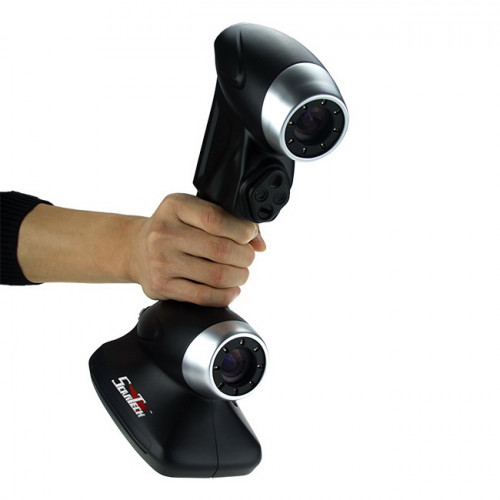
| Brand | Product | Technology | Os compatibility | Accuracy | Max resolution | Wireless | Weight | Country | Price Approximate starting prices based on supplier-provided information and public data. Prices may vary by region, over time and do not include additional products or services (taxes, shipping, accessories, training, installation, …). | |
|---|---|---|---|---|---|---|---|---|---|---|
| peel 3D | peel 2 | Structured light | Microsoft Windows | 0.1 mm0.003937 in | 0.5 mm0.02 in | 0.95 kg2.09 lb | Canada | $ 8,0908 090 €6,706 £1,090,273 ¥ | Get a quote | |
| Shining 3D This brand is a certified partner from our network. | EinScan HX This product has been reviewed by our team. | Structured light | – | 0.04 mm0.001575 in | 0.05 mm0.001969 in | 0.71 kg1.57 lb | China | $ 12,00012 000 €9,947 £1,617,216 ¥ | Get a quote | |
| Creaform | HandySCAN 307 (SILVER series) | Laser triangulation | – | 0.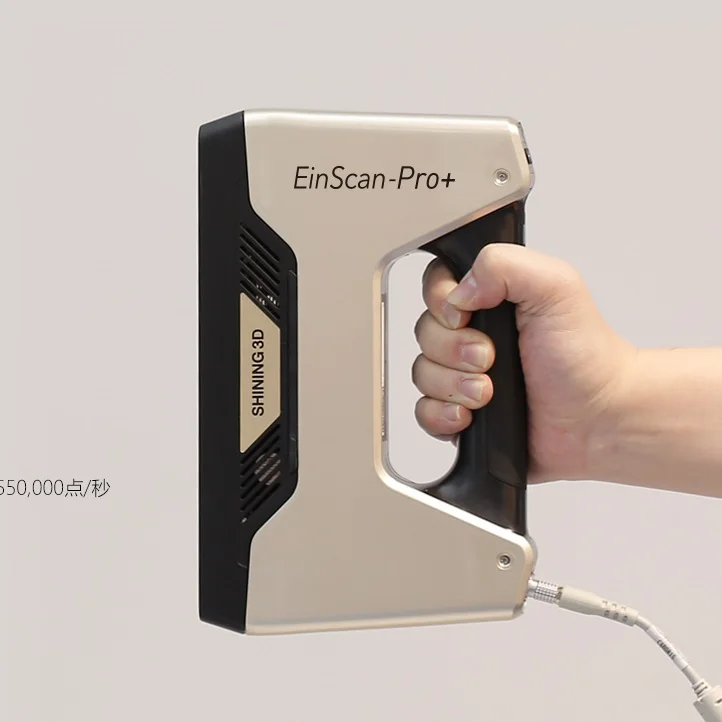 04 mm0.001575 in 04 mm0.001575 in | 0.1 mm0.003937 in | 0.85 kg1.87 lb | Canada | $ 21,90019 900 €18,153 £2,951,419 ¥ | Get a quote | |
| Shining 3D This brand is a certified partner from our network. | FreeScan UE Pro This product has been reviewed by our team. | Laser triangulation | – | 0.02 mm0.000787 in | 0.01 mm0.000394 in | 0.84 kg1.85 lb | China | $ 24,00022 000 €19,894 £3,234,432 ¥ | Get a quote | |
| Artec 3D | Leo | Structured light | Microsoft Windows | 0.1 mm0.003937 in | 0.2 mm0.007874 in | 2.6 kg5.73 lb | Luxembourg | $ 29,80029 800 €24,701 £4,016,086 ¥ | Get a quote | |
| SCANTECH (HANGZHOU) CO., LTD This brand is a certified partner from our network. | SIMSCAN This product has been reviewed by our team. | Laser triangulation | – | 0.02 mm0.000787 in | 0.02 mm0.000787 in | 0.57 kg1.26 lb | China | upon request | Get a quote |
Overview of the best handheld 3D scanners under $30,000
In this section, we give some more context and information about each 3D scanner from our selection.
Peel 3d is a subsidiary of Creaform, a leading 3D scanner manufacturer. They first created the original peel 3d (which we reviewed a while back) in order to tap into the entry-level 3D scanner market.
This second-generation peel 3D scanner offers a higher resolution than its predecessor, and is capable of capturing textures and colors. It is available with a smaller scan volume as the peel 2-S version was designed for parts measuring between 5 and 50 cm.
Peel 3D scanners are easy to use, even for beginners with little 3D scanning knowledge. The software that comes with the peel 2 is also intuitive and user-friendly, offering multiple editing functionalities.
Contact manufacturer Get a quote Add to comparison
The EinScan HX is a follow-up to the first-generation EinScan-Pro, EinScan Pro HD, and later EinScan Pro 2X and 2X Plus. In this price range and at this level of performance, the flagship EinScan HX is unrivaled.
This portable 3D scanner features hybrid 3D scanning technology: its rapid mode is based on structured light, while the fine mode uses laser triangulation. The HX is capable of color and texture acquisition, too.
It is a powerful and versatile product that is capable of acquiring difficult surfaces (reflective, dark, or both) and adapting to parts of all sizes. Shining 3D also made great efforts in terms of weight and design; the HX is well-balanced and comfortable to use.
Read the full review: Shining 3D EinScan HX review
Contact manufacturer Get a quote Add to comparison
The SILVER series is a mashup of old and new recipes, combining the HandySCAN 307/700’s excellent reputation with ongoing updates to an already highly capable software.
We reviewed the HandySCAN 700 (HS700) twice; it is identical to the HandySCAN 307 aside that it features a single laser line mode and offers a slightly higher accuracy (0.03mm versus 0.04mm).
In short, we believe that the HandySCAN SILVER Series is an excellent option with a well-rounded and professional software suite. We highly appreciate the fact that the software saves every bit of information from each scan before letting you decide (reversibly) what you keep and which mesh resolution you want.
Read the full review (HS700 version): Creaform HandySCAN 700 review
Contact manufacturer Get a quote Add to comparison
The FreeScan series is a step above the EinScan series, namely in terms of accuracy and repeatability. It is a recent upgrade to the FreeScan X, boasting a faster acquisition rate, larger scanning range, lighter weight, and more competitive pricing.
This blue laser 3D scanner offers metrology-grade precision and repeatability, all while being able to scan difficult surfaces in a wide range of environments and industries.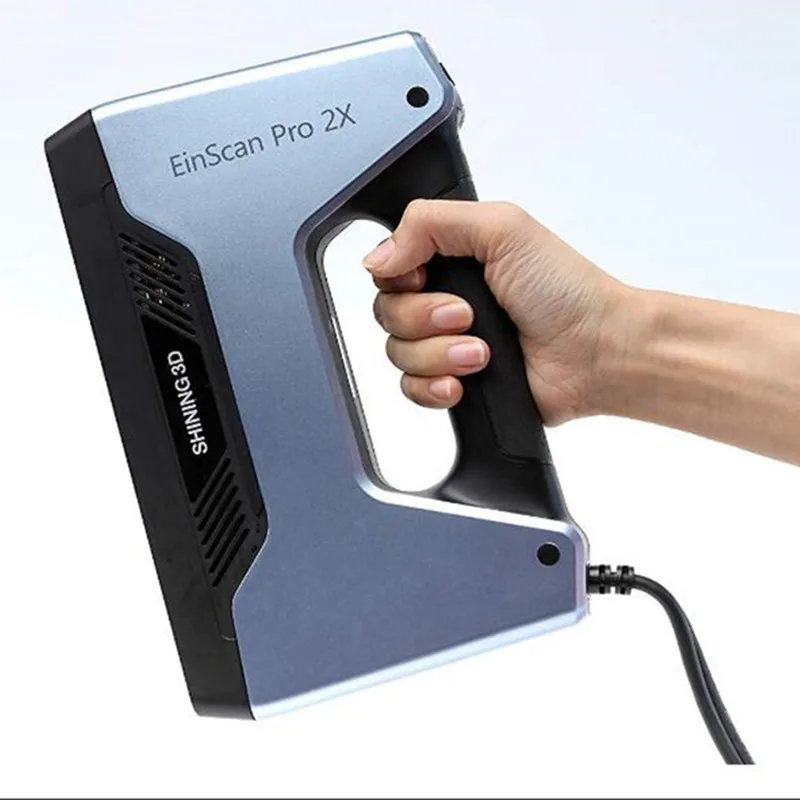 Common industries and applications for this type of 3D scanner include the automotive industry, transportation, mould inspection, energy manufacturing, aerospace, and machine manufacturing, among others.
Common industries and applications for this type of 3D scanner include the automotive industry, transportation, mould inspection, energy manufacturing, aerospace, and machine manufacturing, among others.
The FreeScan UE Pro offers three scanning modes: 13 laser crosses for quick scans or large objects, 5 parallel laser lines to scan fine details, and a single laser line for deep holes and pockets.
Contact manufacturer Get a quote Add to comparison
The SIMSCAN is extremely lightweight for a handheld 3D scanner, weighing only 570 grams. It’s also very compact– the absolute smallest in its class– with dimensions of 203 x 80 x 44 millimeters. Scantech earned a Red Dot Design Award in 2021 for the SIMSCAN’s disruptive design.
After using the SIMSCAN to 3D scan various types of parts, we can confirm it’s an excellent product that feels, looks, and works great. With a price of around €25,000, the SIMSCAN’s price-to-performance is outstanding. The only blemish lies in the software, but it receives updates regularly and you can export your scans to your preferred suite.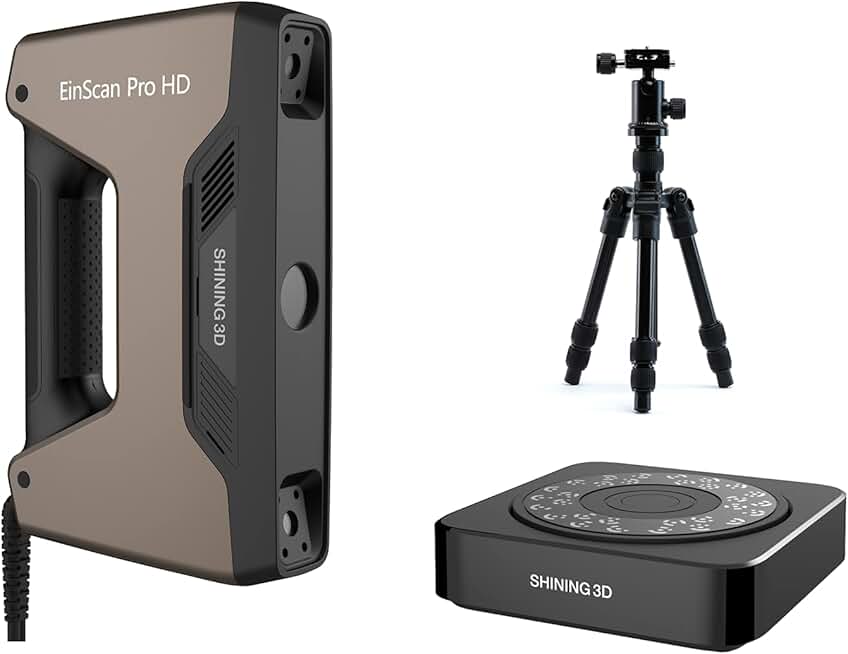
Read the full review: Scantech SIMSCAN review
Contact manufacturer Get a quote Add to comparison
The Artec Leo has been one of the only wireless 3D scanners on the market since its original launch in 2017. It features an onboard processor to capture all data locally, and a large screen that offers real-time 3D visualization.
For its five-year anniversary in March 2022, Artec3D revamped the AI-based Leo with a new processor, the NVIDIA Jetson TX2. It is said to double the Leo’s speed and overall performance. Artec3D now also sells the Leo with a calibration certificate to guarantee its accuracy.
The Leo 3D scanner is a great option, namely in hard-to-reach areas or wherever it can be complex to plug in the Leo and a laptop. However, for more standard use cases, keep in mind that the Leo weighs 2.6kg; that’s around x5 times heavier than the most lightweight portable 3D scanners.
Contact manufacturer Get a quote Add to comparison
Portable 3D scanner buying guide
Before choosing a portable 3D scanner, it’s important to take certain elements into account.
Purpose: What do you need your 3D scanner for?
Today’s handheld 3D scanners are very versatile and can be used for multiple use cases in various industries. Nevertheless, there are a few questions you can ask yourself to help make the right choice.
- How big or small are the parts you’re going to scan? This will determine your field of view. Some 3D scanners have multiple modes or fields of view to handle small, medium, and large parts, while some are specially designed for small pieces.
- Are you already familiar with 3D scanning? If you’re new to 3D scanning, you may want to look out for streamlined workflows. Some brands have several product generations of experience and provide more intuitive software.
- Do you need to acquire colors? Many recent handheld 3D scanners boast texture/color capture, but this feature isn’t standard. It is quite rare on 3D scanners that focus on metrology applications, as having color maps could be superfluous when you just want to inspect a part’s shape.
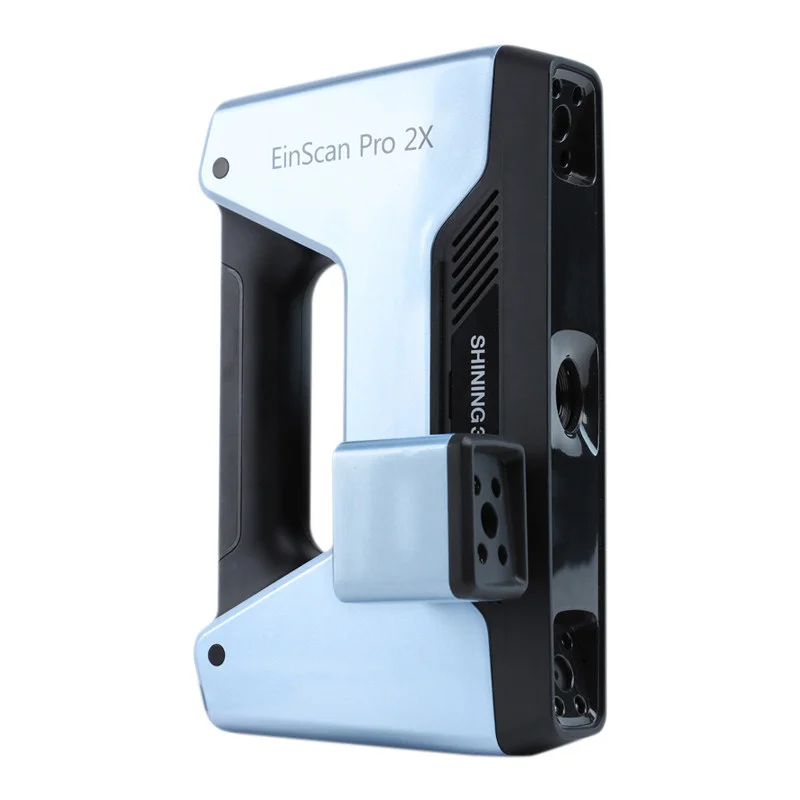
- Will you be 3D scanning every day? Perhaps you’d prefer a 3D scanner that’s easy and quick to set up and put away.
3D scanning can serve an amazing amount of purposes– determine yours before you choose a handheld 3D scanner.
Handheld 3D scanner specifications
Accuracy
A 3D scanner’s accuracy is its ability to obtain exact measurements. In certain industries, like quality inspection, high accuracy is of utmost importance. Entry-level handheld 3D scanners generally boast accuracies around 200 microns, while more premium products can go down to 20 microns.
Resolution
Just like with photos or screens, the level of resolution will count more or less depending on the amount of detail you need. In 3D scanning, resolution is generally measured in point-to-point distance.
Speed
The speed factor is especially important when 3D scanning large objects and landscapes (where SLAM/iMMS scanners shine), or for 3D body scanning.
Large objects take a while to scan, and some 3D scanners require you to stand still for a few seconds before moving on to the next perspective. Keep in mind that you’ll be “pointing and shooting” with your handheld 3D scanner in your hand; the longer you carry it, the heavier it feels.
Nonetheless, some 3D scanners like the Go!SCAN SPARK or the EinScan HX allow you to easily pause and resume from anywhere thanks to efficient automatic scan alignment.
Budget
Last but not least, and as is the case for so many other products, budget is definitely something to take into account. There are cheap handheld 3D scanner options for under $1,000 if you’re willing to sacrifice accuracy and performance (see our “Affordable 3D scanner” selection here).
Industrial 3D scanners are the most expensive, with advanced 3D scanning technologies and prices around $100K. Unless you need a 3D scanner for 24/7 automated quality inspection or other very specific use cases, an entry or mid-level 3D scanner will suit you.
FAQ
How much does a handheld 3D scanner cost?
Mid-range handheld 3D scanners tend to cost between $10,000 and $30,000. There are affordable handheld 3D scanner options under $1,000, and high-end, metrology-grade handheld scanners priced at over $50,000.
How accurate are handheld 3D scanners?
High-end handheld 3D scanners can reach an accuracy up to 0.020mm. Entry-level, affordable scanners offer a scan accuracy of around 0.10mm.
Best 3D Scanner - The Top 10 3D Scanners for 2023 [Reviews]
Much like a regular scanner, laser scanning 3D uses various methods to analyze a physical object and then relay that data to a computer to create digital 3D models. The 3D digitizer process might be automatic or users might need to complete the model to their requirements by using software. The aim is usually to get an accurate model to the right standard and format, ready for 3D printing, for virtual reality applications or other purposes.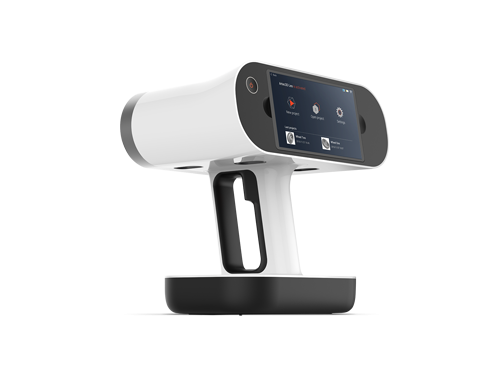
Such scanners are used in many professional industries, but with advances in home 3D printing, there are now also a good variety of home options. They are sometimes called portable 3D scanners or handheld scanners if they’re designed as such. These allow you to easily scan small to medium-sized objects for 3D printing.
Some come completely assembled while others, like 3D printers themselves, you’ll have to put them together by yourself. The benefit for those that are good with that type of thing is it reduces the price and allows for easier upgrades and modifications.
Scanning is typically done using laser triangulation or various forms of structured light to surround the object and measure its 3D dimensions or ‘geometry’. High-quality 3D scanner camera lenses also capture the color and surface texture of the object. Using accompanying or third-party software, the model can then be scaled up or down, or completely modified.
It’s never been easier to scan 3D objects!
How Do 3D Scanners Work?So, how do you scan 3D objects into a computer? Whether it’s on an industrial scale, at a small business, or on a desk at home, 3D scanners all share similar characteristics in the way they work.
The majority use laser and/or white light technology and cameras. The physical object is placed in a bed, tray, or suitable location. Electromagnetic light bounces off the object, measuring its circumference, full dimensions, and all its finer details.
Depending on the scanner it may use multiple light sources, cameras, and other tech to aid this process. The collected data is called a point cloud, which refers to the number of points captured by the laser.
The more points collected the more accurate the scan. A high-resolution scanner can capture hundreds of thousands of points in seconds and reach millions overall. The whole process only takes a few minutes.
While the light tends to be a measure of the object’s geometry, HD cameras tend to capture the surface detail and color.
The data recorded can then be fed into a computer-aided design program or similar software for inspection and manipulation. E.g. if you’re planning to use it for 3D printing, the model might need scaling up or down, hollowing, have added support structures, be re-colored or have brightness/contrast changes, etc.
E.g. if you’re planning to use it for 3D printing, the model might need scaling up or down, hollowing, have added support structures, be re-colored or have brightness/contrast changes, etc.
There are, of course, different types of 3D scanner and scanning technology. So, let’s take a closer look at each one:
Types of 3D ScannersThere are several 3D scanner types. Before making your decision check out the section below:
Handheld vs StationaryHandheld and stationary 3D scanners often use the same technology and can overlap in their functions. The difference lies mainly in the design.
A handheld scanner has a grip and lets the user move around the object themselves to capture it at every angle.
A stationary scanner has to be positioned in front of the object, which is typically placed on a rotating plate and captures it as it spins 360 degrees. The user may have to reposition the object several times to capture every angle.
The user may have to reposition the object several times to capture every angle.
Newer designs are becoming smaller and more easily portable.
Laser TriangulationThe most common technology used in 3D scanning is laser trigonometric triangulation. It records millions of different points on the surface of the object to build an accurate overall polygon mesh. These are common in handheld options and industrial-grade scanner machines. They can also work long-range and for laser-tracking objects.
Structured-Light 3D ScannersSimilar and often used interchangeably with laser triangulation, structured light or ‘white light’ projects itself in a grid-like pattern over an object. It can then measure the structure of that grid as it applies to the object by using sensors/3D scanner cameras and triangulation.
Long RangeLonger range scanners use phase shift or pulse technology that can capture millions of points while rotating 360 degrees with the aid of mirrors.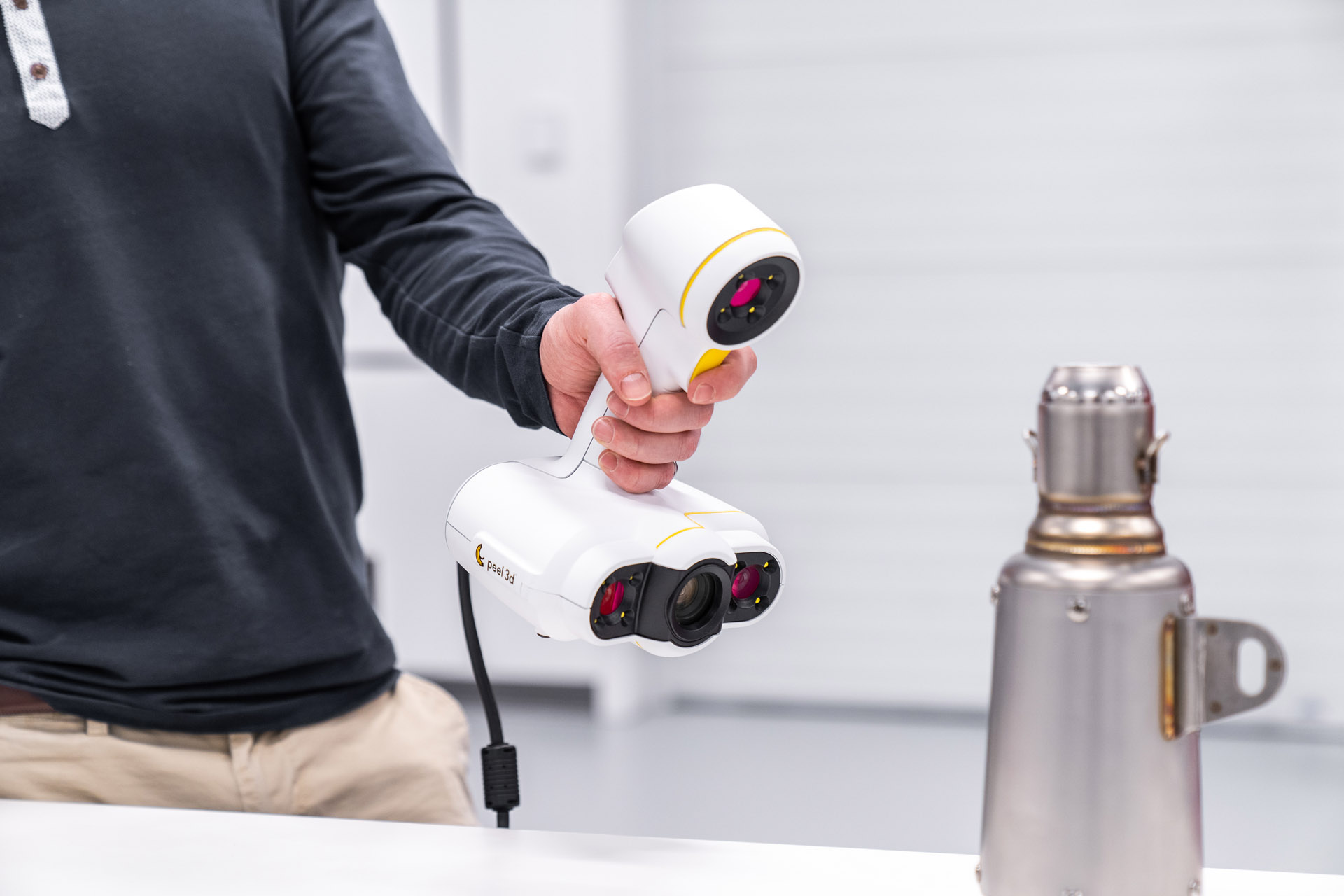 This is more commonly used to scan large objects like cars or buildings.
This is more commonly used to scan large objects like cars or buildings.
They might also use ‘time of flight’ technology that measures the distance of an object in relation to the speed of light and the time it takes for it to return to a sensor.
This is less relevant for everyday 3D scanning and printing.
3D Scanning ApplicationsThere are many different applications for 3D laser scanning - from those for 3D printing at home, to prototyping, industrial scale medical supply production and even architecture.
Hobbyist 3D printingCheaper 3D scanners are typically used by home users for scanning simple objects and 3D printing them for fun.
MedicalThe medical field and dentistry commonly use 3D scanning to create implants and aids to serve their patients’ needs. For example, scanning people’s feet with a high-quality 3D scanner allows for the creation of orthotics (shoe inserts). It is also used in the creation of prosthetics.
It is also used in the creation of prosthetics.
Industrial 3D scanners are used both in the creation and quality control of cars, planes, and even aerospace. It ensures existing parts are as accurate as their original models and that new viable parts are made.
Reverse Engineering and RepairsFrom the home computer desk to the manufacturing floor, 3D scanning allows users to reverse engineer or copy existing objects. Saved models also allow for the reconstruction of damaged objects.
Virtual RealityFrom creating realistic 3D worlds to the people that occupy them, 3D scanning devices are integral to the growing virtual reality industry. This ranges from AAA video games, virtual cinematography, and computer-generated imagery (CGI), to virtual tours and office meetings. It is also a side industry to motion capture.
ForensicsCSI has come a long way.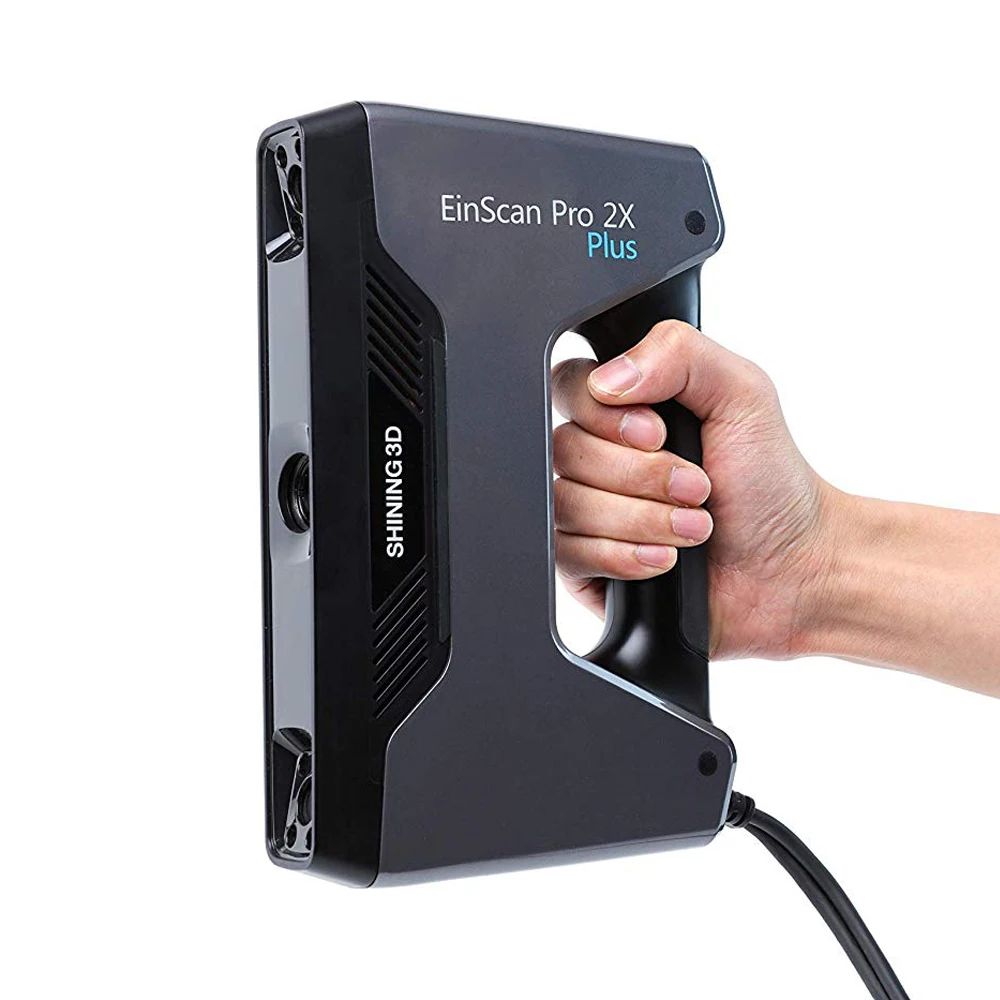 Forensic experts nowadays don’t just have to rely on memory, photos, and evidence of a crime scene. They can capture the entire location in a full 3D model for closer inspection and for running through different scenarios.
Forensic experts nowadays don’t just have to rely on memory, photos, and evidence of a crime scene. They can capture the entire location in a full 3D model for closer inspection and for running through different scenarios.
From museums to libraries, 3D scanning is being used to log and preserve everything from artifacts to digitizing books. This also gives experts and the public remote access.
Architecture3D scanning can also help architects map the areas they will be designing their buildings in, take inspiration from existing architecture, and aid in building miniatures/prototypes.
What Should I Know Before Buying a 3D Scanner?Before you buy a 3D scanner, there are several things to consider:
- your budget
- what you’ll actually be using it for
- it’s speed and accuracy
- the device’s other features.
3D laser scanner price ranges vary greatly. On the cheaper end, you may be able to pick one up for home for just shy of $300, like the XYZprinting 3D Scanner 1.0 A. However, if you want the highest overall quality and the ability to scan small and large objects. Or, if you’re a professional and need a 3D part scanner in a field like medical implants or automotive parts, you’re looking at anywhere between $3,000 and $35,000.
Typically, it’s best to look for 3D scanners for sale online where you can find the best selection and prices.
3D PrintingWhile a dual 3D printer scanner combo is rare, if you want to scan models for 3D printing, you will need to make sure it has good accuracy and resolution. The software also must be able to export to a usable format. You will need to check your 3D printer and its own software to see what file types it accepts and then choose your scanner accordingly.
Fortunately, almost all of our 3D scanner reviews include devices that can export in common file types like OBJ and STL.
It’s typically only the more expensive scanners that are good for other applications, like VR, full-body scanning, architecture, and engineering.
Handheld vs StationaryWe already explained the difference, but basically, a handheld scanner is mobile, while the stationary one will require you to move and adjust the object. Neither is necessarily better than the other, it’s all down to your needs.
SpeedHow fast is the scanner? Do you have a lot of spare time or require the job to be done as fast as possible? All 3D scanners will take a few minutes to complete, while many scanning complex objects in high resolution can talk half an hour or longer.
Accuracy and ResolutionAccuracy refers to how close to the object being scanned your digitized model will be, measured in millimeters. Therefore, the smaller the better. The term resolution may be used interchangeably with accuracy or refer to the resolution of any cameras being used as part of the scanning process.
Generally, the lower the millimeter, the better. Other factors also play a role in overall quality, such as lighting conditions, color, and depth.
Object Size and SpaceSome types of 3D scanners excel at scanning small objects while others are better at medium to large. Others are all-rounders. Before buying a scanner, you should decide the general size of the items you will be scanning.
You will also need to make room for the scanner. Although all the products on our list are small and relatively portable, stationary scanners at least need a table to work from. Likewise, there will be a minimum and maximum distance the scanner must be in relation to the object being scanned.
You’ll need more room when scanning larger objects in full.
All 3D scanners need to be connected to a computer or device to help monitor the process and for saving the digital model. This is usually done via a USB or HDMI cable. You will need to check that your computer or laptop meets the minimum requirements for the scanning and modeling software. Also, make sure that you have a tablet to make real-time monitoring easier.
SoftwareYour device will either come with its own software or a popular third-party program to aid the process and to help touch-up the model once it’s scanned. Different 3D printing software is better suited to different skill levels. Some programs have a lot of features for experienced users and others do most of the basic tasks automatically. Check our 3D scanner reviews to see the software each device comes with and how advanced and easy to use it is.
we choose the best in 2022 in our direction
In order to expand the user audience, SHINING3D offers universal solutions - the same 3D scanner is able to satisfy the needs of ordinary consumers and large businesses and be in demand in the conditions of industrial production of products. Based on the feedback, comments and reviews of device owners, taking into account their needs, the developers have improved the line of models, making 3D digitization and additive technologies even more accessible. 9Ol000 Transcan C
EinScan Series 3D Scanners
For Beginners, Designers or Education
th To apply scanning of relatively small objects, precision and advanced settings in the snapshot processing program are required. The first thing users are guided by is the scanning area. With the help of two models - EinScan-SP and EinScan-SE - it will be possible to scan an object from 30 × 30 mm. Very important for the buyer and their price, as well as mobility and ease of movement.
EinScan-SP and EinScan-SE are useful for beginners, designers and educational users. Desktop scanners SE and SP are the easiest to learn.
Key benefits:
- Easy scanner setup with Plug and Play technology;
- Russian software interface;
- the ability to scan objects of different sizes - from small to large;
- texture tracking.
- one scan time - 4-8 seconds;
- Russified software;
- automatic and fixed operation;
- Align scanned data with marks.
- 8 seconds per scan;
- time required for 360 degree scanning in Auto Scan mode - 2 minutes;
- Russified software;
- automatic alignment of multiple scans;
- API access service for 3D printers of any brand.

Scanners for objects of different sizes
Due to their large dimensions, some parts need to be scanned from a distance of several meters - in this case, portable devices are used. In this category, models with the “H” index successfully demonstrated their capabilities: EinScan H , EinScan HX from the line of mobile hybrid devices. If you choose by price, the most affordable is the portable EinScan H.
Two of these models stand out from the list of products that SHINING3D produces by the presence of hybrid light sources:
- EinScan H - an invisible infrared emitter spectrum has been added to the LED backlight;
- EinScan HX - white LED light combined with a blue laser.
This high-tech solution makes it possible to use these two professional scanners. Manual mode allows you to scan objects of different sizes - medium and large.
To improve the accuracy of the photographs, glossy surfaces are treated with a matting spray.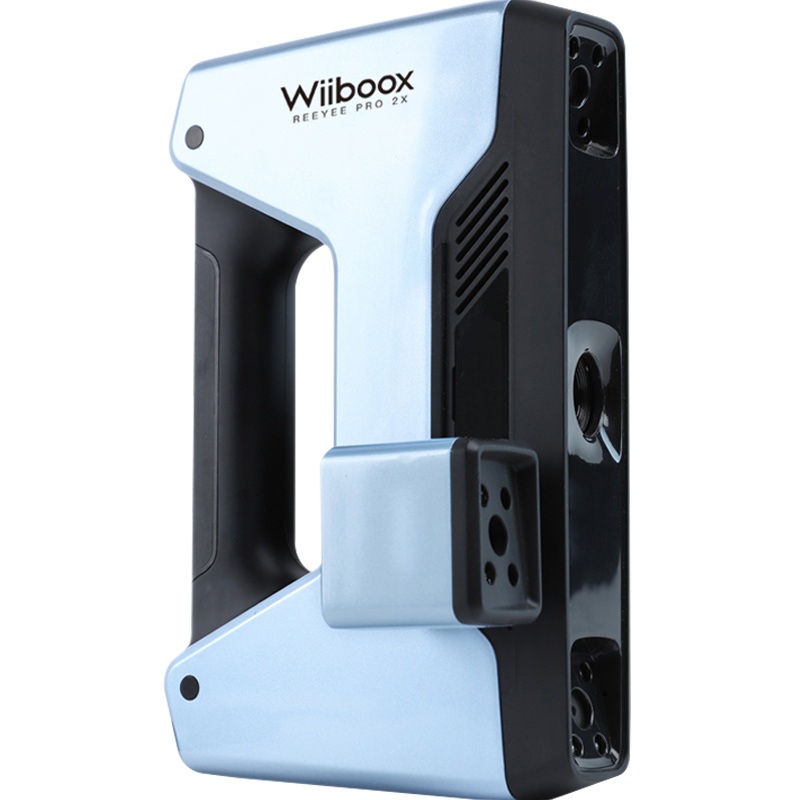 But with the help of some devices, the digitization of such objects is performed without preliminary application of auxiliary compositions to their surface, which saves a little time.
But with the help of some devices, the digitization of such objects is performed without preliminary application of auxiliary compositions to their surface, which saves a little time.
- Structured radiation from an LED source and a scanner laser projecting crossed laser beams onto the surface.
- In Laser Scan mode, object scan accuracy is 0.04 mm.
- Minimum distance to point is 0.05 mm in laser mode.
- High efficiency in fast scan mode - 1,200,000 points/s.
- Full color reproduction of the part.
Copying accuracy is so great that when scanning objects of works of art, it is possible to obtain an almost perfect replica. For medical institutions, this is also a worthy find. Separately, it should be noted the presence of a built-in color camera.
There is a free download of PC software with many functions for setting up and calibrating equipment. The installation package is also supplied on a USB stick if you need a stand-alone installation in the absence of Internet access. Even an operator without experience and knowledge can work with the intuitive interface of the program, which saves time on staff training.
Even an operator without experience and knowledge can work with the intuitive interface of the program, which saves time on staff training.
3D scanning of people and their faces
If living objects are selected for work, a special scanning technology is required. You can get a digital copy of a fragment of a human body, face and hair using EinScan H hybrid models - thanks to two light sources and a color camera, they produce an ideal 3D model with texture preservation. A special requirement for the model: it must not move.
- Two scanning technologies - LED and infrared light, invisible to the human eye, combined in one device.
- Scanning people (portrait, full-length) and other living objects.
- High accuracy of scanned data up to 0.05 mm and volumetric accuracy of 0.1 mm/m.
- Resolution up to 0.25 mm.
- Fast scanning and large scanning FOV 420 × 440 mm.
According to experts who have been conducting research in the world of additive technologies for many years, specific criteria are set for certain tasks: the more complex the part geometry, the higher the scanner resolution should be. But it will also take more time to digitize, and the file size will increase due to the multiplication of the number of cloud points with a smaller distance between them.
But it will also take more time to digitize, and the file size will increase due to the multiplication of the number of cloud points with a smaller distance between them.
Of the three samples, the HX version is the universal laser scanner model, and the Einscan Pro HD/Einscan Pro 2x 2020 are multifunctional scanners that have the ability to perform tasks in various industries.
The EinScan Pro HD is an upgrade from the older model of the Einscan Pro 2x series, thanks to its ergonomic and high quality design. Models in this range can be used with a special tripod.
This professional 3D scanner provides high precision scanning of objects in both operating modes: up to 0.045+0.3 mm/m.p. in manual mode and up to 0.04 mm. in fixed scan mode.
Manual object scanning has two submodes: Rapid and HD, the latter providing a higher level of detail (resolution). Depending on the complexity of the geometry of the object, the presence of deep holes and 3D scanner parameters, such as resolution (distance between points), the final image may require further processing in the program.
The maximum possible scanning speed for this scanner is 3 million points per second. Even if we ignore the specifications, we can see that this device is extremely fast in real-life scenarios. For example, a 220 x 71 cm low-relief sculpture takes less than one minute to digitize in color.
Scanning of human bodies is also possible with this device, it provides decent quality. Last but not least, using a 3D color scanning camera with the device allows you to get scans with color and texture and realize even more projects. To keep the best price and reduce costs, manufacturers offer such cameras as an additional Color Pack option, which is paid only by those consumers who work with texture models and who really need it.
EinScan HX is more expensive than the EinScan H scanner, and functional professional scanners, which include the EinScan Pro HD, are traditionally more expensive than other classmates and therefore are available to large manufacturers in the field of additive technologies.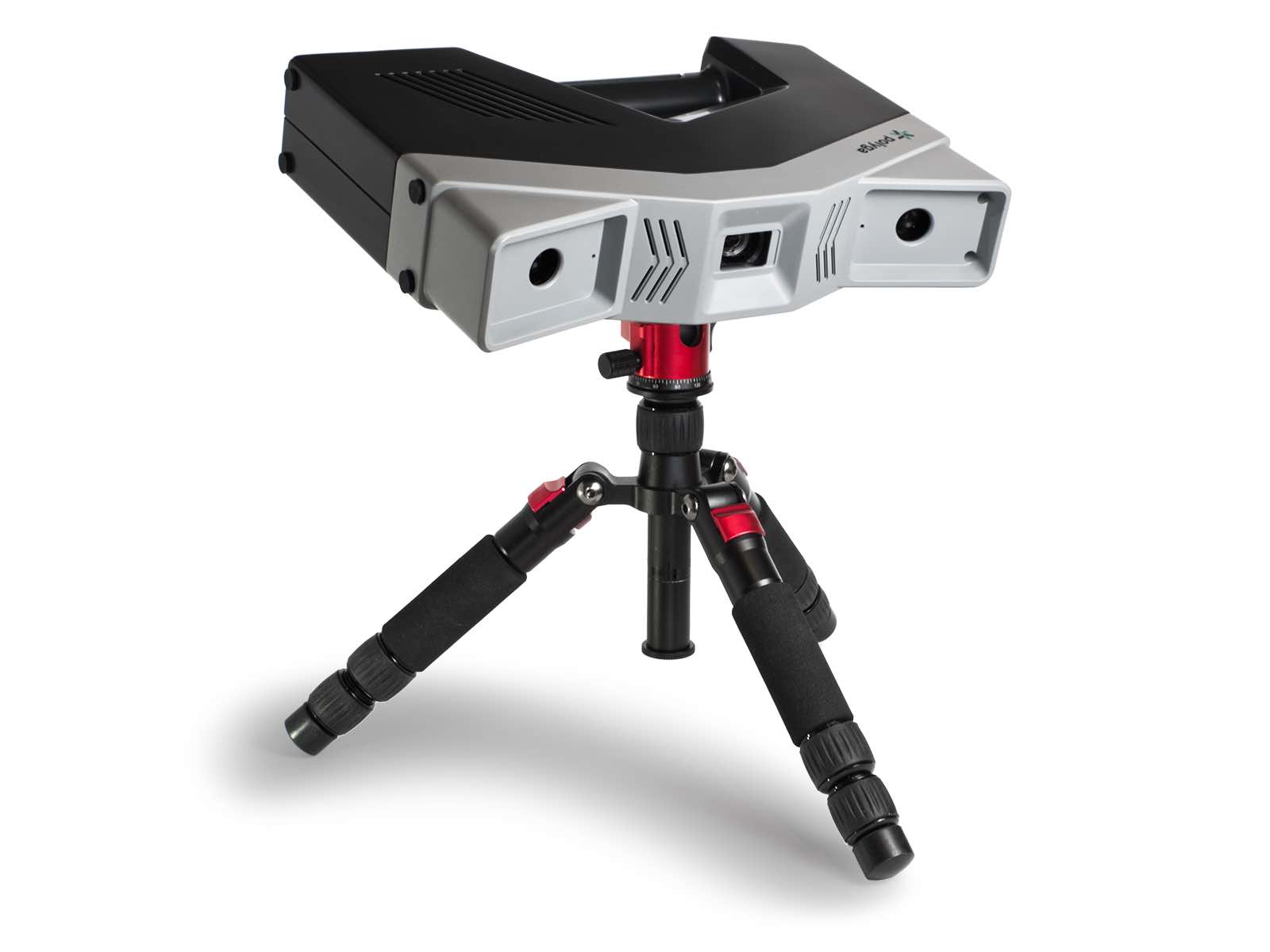
EinScan Pro 2X 2020 3D Scanner
This portable and versatile handheld 3D scanner helps you get highly accurate results.
The EinScan Pro 2X 2020 3D Scanner is an excellent option for scanning small, medium and large objects.
3D scanner EinScan Pro 2X 2020The updated scanner model has improved the main characteristics, added new 3D scanning algorithms. Thus, Einscan Pro 2x 2020 has become a more affordable version of Einscan Pro HD, retaining the advantages and features of the old model.
The main improvements of the new model:
- The new principle of 3D scanning of the device in manual HD mode, which allows scanning without the use of markers (as Einscan Pro HD does). The old model could not scan without markers in this mode. The quality and detail of scans have also been improved.
- Higher device scanning accuracy in manual HD mode, improved volumetric accuracy for scanning large objects.
- Higher scanning speed in manual HD mode.
- Increased 3D scan area.
- Added alignment modes in manual HD mode: alignment by markers, by geometry, hybrid alignment. This expands scanning capabilities and efficiency in a wider range of tasks and areas.
Einscan Pro 2x 2020 3D Scanner is compact and lightweight, you can take it with you anywhere. It has a comfortable handle and is light (namely 1.13 kg) and easy to hold in your hand, and if you need HD mode accuracy, put the scanner on a tripod. The scanner is connected via USB 3.0 to a computer or laptop.
According to experts, the latest developments in the field of data capture and optimized algorithms make the 3D scanner Einscan Pro 2x 2020 a truly breakthrough - its scanning speed reaches 1,500,000 points per second (at 30 frames per second) in manual scanning mode.
If you need to expand the functionality of the scanner, Shining 3D offers several optional options:
- Color Pack 3D Scanner is an optional camera that allows you to scan with color and texture.
- Industrial Pack - accessories such as turntable and tripod. Suitable for high quality scanning of small objects in the studio.
Transcan C 3D Scanner
The Transcan C 3D Scanner is a professional scanning grade scanner capable of capturing "exceptionally" accurate, high-resolution scans of small to medium-sized objects thanks to two 12-megapixel color cameras with adjustable scan range and multi-level switching permits within a single project.
The 3D scanner features a sliding design that allows you to easily switch between 150 x 96mm and 300 x 190mm scanning ranges when working with objects of different sizes. The multi-resolution fusion algorithm makes it possible to mix high, medium and low resolutions in one project, which makes the scanner much more efficient, and its two cameras can capture a 24-bit color map to capture detailed 3D color data and provide better results.
The Transcan C has a structured light scanning mode with an automatic turntable that, in combination with the scanning software's stitching algorithm, allows efficient 3D model acquisition without manual intervention.
What other indicators you need to look at to choose what you need
The technical characteristics of the devices determine their use in a particular area: in jewelry, high detail is required, in industry - accuracy, in art - the possibility of color digitization, in the field of education - ease of setup and others. Of course, the properties are considered in a complex: the most important parameter is considered as the basic one, the rest are considered as auxiliary, but at the same time mandatory.
3D Scan Accuracy
The degree to which the copy matches the original is perhaps the most important indicator. The technical characteristics of scanners indicate the maximum allowable deviation of the scan size from the real object. The indicator is measured in millimeters or microns (1 micron = 0.001 mm). The smaller the number, the more accurate the 3D scan will be. But the deviation in reality can be larger, since it is quite difficult to create ideal conditions for the device to work, the result is affected by:
- characteristics of the object;
- user qualification;
- scanner settings.
It is important to understand that accuracy and resolution are different characteristics of scanning equipment. Detail is the smallest distance between points, the limitation of which is due to the resolution of the cameras and the principle of the scanner.
Ability to digitize in motion
Triangulation 3D scanners will help to scan moving objects, which can lead to an increased cost of devices of this type. This technology is not usually found in handheld 3D scanners, but among the offerings of the company with a rich history of SHINING 3D is the 2020 model EinScan HX, which at that time implemented triangulation technology.
The use of professional 3D scanners in metrology
3D scanners cope with the processes of measuring sizes and shapes of models in a matter of minutes, unlike traditional coordinate measuring machines, in which coordinates are read by contact sensors. The non-contact mode of operation enables the device to scan and measure surfaces of complex shapes (internal corners and edges), recesses and other hard-to-reach places.
After receiving all the necessary data during the processing of the object, they are transferred to the computer for processing. The program performs a comparison of indicators in order to identify deviations - a mismatch in shape and size, the presence of chips, cracks and other deformations caused by mechanical stress or corrosion processes.
Innovatively adapted blue laser 3D scanning technologyOptimScan-5M, 3M and AutoScan Inspec "scanner-inspector" are designed for metrology purposes for scanning a small object. All these devices to some extent belong to the same price niche, are multitasking, provide an opportunity to obtain high-quality digital 3D models for comparison with reference samples, demonstrating:
- the highest scanning accuracy;
- the ability to upload scans to processing programs;
- compatible with CAD/CAM technologies;
- work with objects of various sizes and shapes, including those with complex geometry;
- texture tracking and color imaging.
Professional, they are also industrial, 3D scanners help to perform a wide range of tasks:
- reverse engineering;
- ultra-precise 3D quality control;
- implementation of intermediate stages of the technological chain of creating products using additive technology;
- faster prototyping and other operations.
On the Russian market, you can find interesting offers for the purchase of scanning devices for photogrammetry at a fairly reasonable price. However, you should pay attention to their characteristics, especially such as the resolution of cameras, the distance between points, and some others that are important for measuring instruments, since the accuracy of the results depends on them.
3D scanning in mechanical engineering
Integration of 3D scanning technologies into production processes provides undoubted preferences. Properties of modern industrial scanners:
- high speed;
- ultra-precise measurement and digital copy saving;
- processing of objects regardless of the size and complexity of the form;
- possibility of implementation in automated process control systems.
With the help of 3D scanners and specialized software, numerous processes can be performed:
- reverse engineering, or reverse engineering;
- metrological control;
- test measurements of geometric parameters for the purpose of quality control and detection of defects;
- creation of archives of digital models.
Reverse engineering
Reverse engineering of complex shapes is one of the areas of industrial engineering. A physical sample is translated into a digital copy using a 3D scanner, which can be reproduced on CNC machines and turned into a finished product. To do this, the resulting polygonal model is converted into a popular CAD format. The digital copy is modified and modified to achieve the specified parameters. This allows you to move from traditional design to a new level, when it takes several times less working time to work. The finished object becomes the basis for serial production of products.
With a large selection of laser and optical 3D scanners on the market, there are not so many budget devices in this segment that are used for prototyping and solving other engineering and everyday tasks related to 3D modeling.
Quality control
Metrological 3D scanners make it possible to obtain a point cloud of the test sample, on the basis of which an ultra-precise 3D model of the part is formed. It is compared with a digital copy of a reference sample or with an existing CAD model.
Benefits of 3D quality control:
- Absolutely accurate data for reference comparison;
- measurement of millions of surface points;
- high speed operation;
- possibility of automatic operation.
The obtained data can be used for reverse engineering.
Scanners from the metrological category are recommended for quality control. It can be either stationary or portable.
FreeScan UE Handheld 3D Laser Scanner
Shining 3D FreeScan UE is the latest addition to the FreeScan line of high performance 3D scanners. The device uses the patented blue laser technology and features high accuracy and stable repeatability.
Sunny Wong, product manager of Shining 3D, states: “Innovative adaptation of blue laser 3D scanning technology, high precision and stable repeatability, and easy and convenient operation of hardware and software, allow FreeScan UE to effectively and accurately upgrade digital workflows in engineering and inspection tasks, ensuring the quality of the final product.
The metrology-grade FreeScan UE system delivers 0.02 mm accuracy and 0.02 mm + 0.04 mm/m volumetric accuracy. With a maximum scan area of 510 x 520mm, users get a field of view suitable for large-scale reverse engineering projects.
AutoScan Inspec high-precision stationary 3D scanner
AutoScan Inspec- The interface is immediately clear to the user.
- The accuracy of the 3D model reaches the metrological level with an error of 10 µm (0.01 mm).
- The device can be used for non-contact measurement and quality control.
- The process is fully automated.
Works with native software developed by SHINING 3D programmers for industrial applications. The PC communication program supports STL format output files. This simplifies further 3D printing of parts from various transparent photopolymers on a 3D laser printer and saves time on intermediate data processing.
OptimScan-5M 3D Metrology Scanner
OptimScan-5MProfessional metrological 3D scanner OptimScan-5M shows the best consumer characteristics required just for 3D inspection:
- accuracy - 0.
015 mm;
- two 5-megapixel cameras;
- high processing speed;
- blue light scanning technology.
AutoScan Inspec Desktop Scanner is a two-in-one scanner-inspector that works in automatic mode. The scanner performs 3D scanning with the highest precision and 3D inspection of objects. For working with complex parts and the smallest elements, this is one of the best devices:
Solutions for dentistry
In dental orthopedics, 3D scanners – intraoral and dental – have become indispensable assistants for orthopedists and dental laboratory specialists. The former are used for scanning, creating digital impressions and then manufacturing perfectly fitted prostheses, crowns, veneers and other dental restorations using a 3D model using CAD / CAM technology. The second digitizes plaster casts or abutments with tiny elements.
Aoralscan 3Aoralscan 3 is a compact, powerful device with simple and user-friendly operation and updated algorithm:
- Light weight, only 240 g.
for a full arc.
- 2 tip sizes, suitable for adults and children.
- AI Scan - Speed up the scanning process.
- Powerful software, ortho modeling and oral health report.
AutoScan-DS-MIX Dental 3D Scanner
AutoScan-DS-MIXAutoScan-DS-MIX is an exceptional performance dental scanner with two 5 megapixel cameras and advanced blue light 3D scanning technology:
- scanning speed of one jaw - 13 seconds;
- high accuracy - 7 µm;
- data export to virtual articulator;
- the ability to work with non-separable objects;
- own fully Russified Dental Scan software compatible with most CAD/CAM solutions.
Among the 3D modeling and additive manufacturing products offered by SHINING 3D, at an affordable price, you can easily find the right equipment to solve the tasks in industry, medicine, education and everyday life.
Top Ten 3D Scanners Between $100 and $100,000 There are several ways for you: you can of course create your 3D model from scratch in a 3D modeling program or find a suitable one on the Internet, but you can also scan an existing object! The purpose of this review is to help you understand the variety of 3D scanners available and offer the best in every price segment from a photogrammetric smartphone app to professional 3D scanners.
Scanners are listed in ascending price order so you can choose the one that suits your budget and use the resulting 3D models for both 3D printing and animation.
If you are not satisfied with the proposed solutions, there is an extended overview at this link.
3D scanner in hand:
1. Best smartphone app: Autodesk 123D Catch (free)
Autodesk 123D Catch is a free photogrammetric application. It allows you to create a 3D model from photographs of an object taken from different angles. You can use it to scan objects, people, and even the landscape. For some applications, if you don't need perfect accuracy, you don't need special equipment. This application actually provides quite good detail and is easy to use. However, it will take you at least 30 minutes for the app to process your photos as the processing takes place on the server and it takes time to send them.
2. Best DIY 3D scanner: Kinect ($99.99)
The Xbox Kinect is designed to expand your gaming experience. It is not designed for 3D scanning, but you can easily find manuals and third party software (like ReconstructMe) to turn it into a 3D scanner. If your arms are growing out of your shoulders, this is an interesting and inexpensive solution for 3D scanning.
Price: $99.99
Resolution: 0.051 mm
)
This scanner can be attached to your tablet or phone (generally designed for iPad, but can be adapted to other devices). Lightweight and easy to use, with a very good resolution. Suitable for large items (can scan a full-length person) and outdoor scanning. You will be able to use it with software running on Occipital's SDK. This will increase the resolution and give you access to special features like room scanning. It probably won't be something you'll use for 3D printing, but it's interesting for game development, for example.
Price: $ 379
Resolution up to: 0. 5 mm
accuracy to: 4 mm
4. The best of cheap manual 3D scanners: Cubife ($ 399) 9000
3D scanners can be quite affordable and easy to use if you choose from inexpensive portable models. Cubify fits these criteria very well and has a relatively good resolution. But still, its capabilities are not enough for texture scanning and it is better to use it for subsequent 3D printing of one-color models.
Price: $ 399
Resolution: 0.9 mm
Resolution at a distance of 0.5 m: 1 mm
3D scanner on the table:
5. Best and cheapest table 3D 3D 3D- scanner: Matter and Form ($519)
If you're looking to take your quality to the next level, you can purchase a desktop 3D scanner. This model is compact, easy to use, and delivers good resolution, especially considering the price (not your go-to option if you're looking for perfection, but great for educational and demo purposes). The scanning process takes place with the help of a laser and a rotating platform. The scan takes about five minutes and simultaneously reads the texture of the object.
Price: $ 519
Resolution: 0.43 mm
accuracy: ± 0.25 mm
6. The best device "two in one": XYZPRINTING DA VINCI 1.0 ($ 600)
is a short combines a 3D scanner and a 3D printer. The quality of the models is not too high, but the price is very low for such a combined device. This makes the XYZprinting Da Vinci the easiest solution for beginners wanting to get into the world of 3D scanning-printing.
Professional 3D scanners:
7. Best value for money portable 3D scanner: Fuel3D Scanify ($1490)
Very easy to use, intuitive, and feels good in the hand, this scanner delivers good accuracy and texture quality. The only limitation is that the size of the scanned area is limited, which is great for small objects, but for scanning a full-length person, for example, it will not work.
Price: $ 3995
Resolution: 0.06 mm
accuracy: 0.5% of the size of the object
9. The best desktop professional 3D scanner: Solutionix Rexcan 4 ($ 79 900)
This is a professional The 3D scanner and its price provides much better scanning quality. Solutionix Rexcan is equipped with two cameras for greater accuracy. It uses optical phase shift triangulation technology and two high-resolution CCD cameras to provide high-precision data. The scanner can be used to scan larger objects by increasing productivity with a photogrammetric system. As an option, it can be equipped with an automatically rotating platform capable of supporting up to 50 kg of weight.
Price: $ 79 900
accuracy: from 0.03 to 0.71 mm
10. Best professional manual 3D scanner: $ 50,000 - $ 100,000)
Creaform Metrascan 750 is a complete professional, production solution for accurate 3D scanning.



